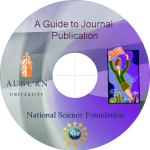

The Writing Process
Completing the actual theoretical or empirical research is only half the battle. You need to be able to clearly present your work to the appropriate audience. Consider the following:
- When writing your paper, be sure to make your main point and results apparent. This starts with the abstract - make sure it is descriptive, clear and cogent.
- Pay attention to the article's title - it needs to be descriptive enough to come up properly during literature searches but not so long as to be burdensome or overly specific.
- When writing your paper, answer these questions: What contribution does this study make to my academic field? Why is this paper not like any others? What is the context of the work in the body of knowledge?
- Make sure you provide enough specific technical details so that the article can be properly understood and the method or experiment replicated. The article should be stand alone - that is, while referencing other written materials, it should be complete and understandable by itself. However, voluminous technical detail can go in an appendix to improve article flow and readability or even in a website cited in the article.
- Pay attention to your graphics. Remember that they will be reproduced in black and white so make sure they are legible in that manner. Be sure that graph axes are labeled and the scales are appropriate. Make sure that graph lines are clearly differentiated. For flowcharts or other figures with text, make sure the text is large enough to be read. Photos should be high resolution digital files that, again, reproduce appropriately in B/W.
- Make sure your review of the literature is up to date, relevant and comprehensive. A shallow or outdated literature review can reflect poorly on your entire paper and reduce its chances for a favorable outcome.
- Do not overly cite your own papers. The author is typically supposed to be anonymous to the referee. Not only will citing your own papers give clues as to your identity, but it may also send across a bad egotistical vibe.
From the Survey of engineering editors, the types of papers most found in engineering journals are listed in order of frequency. In the following table, notice that analytical, theoretical, and conceptual developments equally comprise the majority of engineering journals' papers (roughly 60%). Case studies, literature reviews, and educational material comprise an aggregate 30% of the material as well.
| |
|
Percentage |
| |
|
of |
| Rank |
|
papers |
| 1 |
Analytical
developments |
20% |
| 2 |
Theoretical
developments |
18% |
| 3 |
Conceptual
developments |
17% |
| 4 |
Case
studies |
11% |
| 5 |
Literature
reviews |
10% |
| 6 |
Educational
(or how-to) papers |
10% |
| 7 |
Responses
to already published research |
7% |
| 8 |
Book
reviews |
4% |
| 9 |
Position
papers |
3% |
